Detecting and escaping infinite loops with jolt
Author(s)
Carbin, Michael James; Misailovic, Sasa; Kling, Michael W.; Rinard, Martin C.
DownloadRinard_Detecting and escaping.pdf (257.2Kb)
OPEN_ACCESS_POLICY
Open Access Policy
Creative Commons Attribution-Noncommercial-Share Alike
Terms of use
Metadata
Show full item recordAbstract
Infinite loops can make applications unresponsive. Potential problems include lost work or output, denied access to application functionality, and a lack of responses to urgent events. We present Jolt, a novel system for dynamically detecting and escaping infinite loops. At the user’s request, Jolt attaches to an application to monitor its progress. Specifically, Jolt records the program state at the start of each loop iteration. If two consecutive loop iterations produce the same state, Jolt reports to the user that the application is in an infinite loop. At the user’s option, Jolt can then transfer control to a statement following the loop, thereby allowing the application to escape the infinite loop and ideally continue its productive execution. The immediate goal is to enable the application to execute long enough to save any pending work, finish any in-progress computations, or respond to any urgent events.
We evaluated Jolt by applying it to detect and escape eight infinite loops in five benchmark applications. Jolt was able to detect seven of the eight infinite loops (the eighth changes the state on every iteration). We also evaluated the effect of escaping an infinite loop as an alternative to terminating the application. In all of our benchmark applications, escaping an infinite loop produced a more useful output than terminating the application. Finally, we evaluated how well escaping from an infinite loop approximated the correction that the developers later made to the application. For two out of our eight loops, escaping the infinite loop produced the same output as the corrected version of the application.
Description
25th European Conference, Lancaster, Uk, July 25-29, 2011 Proceedings
Date issued
2011-07Department
Massachusetts Institute of Technology. Computer Science and Artificial Intelligence Laboratory; Massachusetts Institute of Technology. Department of Electrical Engineering and Computer ScienceJournal
ECOOP 2011 – Object-Oriented Programming
Publisher
Springer Berlin / Heidelberg
Citation
Carbin, Michael et al. “Detecting and Escaping Infinite Loops with Jolt.” ECOOP 2011 – Object-Oriented Programming. Ed. Mira Mezini. LNCS Vol. 6813. Berlin, Heidelberg: Springer Berlin Heidelberg, 2011. 609–633.
Version: Author's final manuscript
ISBN
978-3-642-22654-0
ISSN
0302-9743
1611-3349